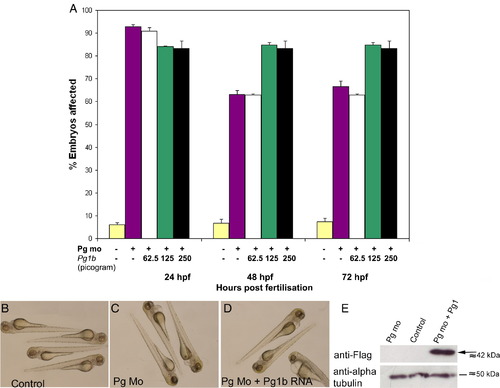Fig. 3
|
Plakoglobin-1b RNA fails to rescue morphant phenotype at three doses. (A) Phenotypic analysis of embryos injected with control morpholino (yellow), plakoglobin morpholino (purple), co-injection of morpholino and either 62.5 pg of plakoglobin-1b (white), 125 pg of plakoglobin-1b (green), or 250 pg of plakoglobin-1b (black). Co-injection of plakoglobin-1b failed to rescue morphant phenotype at any of the doses injected (P < 0.05, vs. control). In 125 pg and 250 pg doses, co-injection of plakoglobin-1b increased the number of embryos with an abnormal phenotype at 48- and 72-hpf (P < 0.05, vs. morphant). (B) Control injected embryos were unaffected and (C) plakoglobin morpholino injected embryos displayed the morphant phenotype. (D) Co-injection of morpholino and plakoglobin-1b RNA failed to rescue the morphant phenotype. (E) Western blot analysis of 24 hpf plakoglobin morpholino, control morpholino or plakoglobin morpholino and plakoglobin-1b co-injected embryos. An anti-FLAG antibody was used to detect FLAG-tagged plakoglobin-1b protein (arrow). An anti α-tubulin antibody was used as a loading control. The presence of FLAG protein confirms plakoglobin-1b was translated. |
Reprinted from Developmental Biology, 327(1), Martin, E.D., Moriarty, M.A., Byrnes, L., and Grealy, M., Plakoglobin has both structural and signalling roles in zebrafish development, 83-96, Copyright (2009) with permission from Elsevier. Full text @ Dev. Biol.

